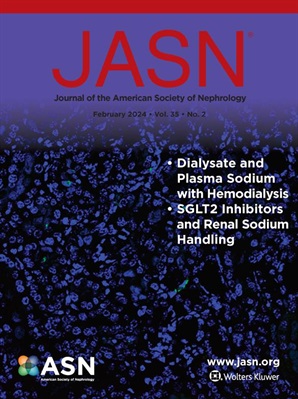2009-2024年美国先发制人肾移植等候名单后结果的种族差异
IF 9.4
1区 医学
Q1 UROLOGY & NEPHROLOGY
引用次数: 0
摘要
背景:对于大多数符合移植条件的晚期CKD患者来说,先发制人的肾移植(在透析开始之前)是最佳的治疗方法。虽然先前的研究已经记录了先发制人转诊的种族和民族差异,但对先发制人等候名单后的不同结果知之甚少。这项研究探讨了种族和民族之间的关系和预先等候名单患者的结果。方法:我们使用来自移植受者科学登记处(SRTR)的数据,对一个前瞻性维持的美国队列进行了二次分析。研究人群包括98,863名首次肾脏移植的成人候选人,他们在2009年1月1日至2020年12月31日期间被预先排队,并随访至2024年12月31日。兴趣的暴露是种族和民族。主要结局是3年先发制人的已故供者肾移植、活体供者肾移植或开始透析。我们使用竞争风险模型来估计调整后的亚分布风险比(aSHRs)。数据按3年为间隔进行分层(2009-2011年、2012-2014年、2015-2017年和2018-2020年)。结果黑人和西班牙裔患者接受预先死亡供体肾移植的频率与白人患者相同(2018-2020年,aSHRs [95% CI]分别为0.99[0.92-1.07]和1.02[0.93-1.12]),而亚洲患者的比例较低(0.78[0.69-0.88])。然而,与白人患者相比,亚裔、黑人和西班牙裔患者更有可能开始透析(aSHRs分别为1.50[1.39-1.61]、1.41[1.34-1.49]和1.21[1.14-1.29]),接受先发制人的活体肾脏移植的可能性更低(2018-2020年,aSHRs分别为0.49[0.44-0.54]、0.31[0.29-0.34]和0.61[0.56-0.66])。在2009年至2020年期间,美国CKD候审患者中,黑人和西班牙裔患者的抢先死亡供体肾移植率有所提高,并与白人患者相当。然而,亚洲、黑人和西班牙裔患者的透析起始率较高,而先发制人的活体肾移植率较低。本文章由计算机程序翻译,如有差异,请以英文原文为准。
Racial and Ethnic Disparities in Outcomes following Preemptive Kidney Transplant Waitlisting in the United States from 2009-2024.
BACKGROUND
Preemptive kidney transplantation (prior to dialysis initiation) is the optimal therapy for most transplant-eligible advanced CKD patients. While prior research has documented racial and ethnic disparities in preemptive referrals, less is known about distinct outcomes following preemptive waitlisting. This study examines the association between race and ethnicity and outcomes for preemptively waitlisted patients.
METHODS
We conducted a secondary analysis of a prospectively maintained U.S. cohort using data from the Scientific Registry of Transplant Recipients (SRTR). The study population included 98,863 adult first-time kidney transplant candidates who were preemptively waitlisted from January 1, 2009, to December 31, 2020, and followed through December 31, 2024. The exposure of interest was race and ethnicity. The primary outcome was three-year preemptive deceased donor kidney transplantation, living donor kidney transplantation, or dialysis initiation. We used competing risk models to estimate adjusted subdistribution hazard ratios (aSHRs). Data were stratified into three-year intervals (2009-2011, 2012-2014, 2015-2017, and 2018-2020).
RESULTS
Black and Hispanic patients received preemptive deceased donor kidney transplants as often as White patients (era 2018-2020, aSHRs [95% CI]: 0.99 [0.92-1.07] and 1.02 [0.93-1.12], respectively), while Asian patients had lower rates (0.78 [0.69-0.88]). However, Asian, Black, and Hispanic patients were more likely to initiate dialysis (aSHRs: 1.50 [1.39-1.61]; 1.41 [1.34-1.49]; and 1.21 [1.14-1.29], respectively) and were less likely to receive preemptive living donor kidney transplants than White patients (era 2018-2020, aSHRs: 0.49 [0.44-0.54]; 0.31 [0.29-0.34]; and 0.61 [0.56-0.66], respectively).
CONCLUSIONS
Among waitlisted CKD patients in the U.S between 2009 and 2020, rates of preemptive deceased donor kidney transplantation improved for Black and Hispanic patients and became comparable to White patients. However, Asian, Black, and Hispanic patients experienced higher rates of dialysis initiation and lower rates of preemptive living donor kidney transplantation.
求助全文
通过发布文献求助,成功后即可免费获取论文全文。
去求助
来源期刊
CiteScore
22.40
自引率
2.90%
发文量
492
审稿时长
3-8 weeks
期刊介绍:
The Journal of the American Society of Nephrology (JASN) stands as the preeminent kidney journal globally, offering an exceptional synthesis of cutting-edge basic research, clinical epidemiology, meta-analysis, and relevant editorial content. Representing a comprehensive resource, JASN encompasses clinical research, editorials distilling key findings, perspectives, and timely reviews.
Editorials are skillfully crafted to elucidate the essential insights of the parent article, while JASN actively encourages the submission of Letters to the Editor discussing recently published articles. The reviews featured in JASN are consistently erudite and comprehensive, providing thorough coverage of respective fields. Since its inception in July 1990, JASN has been a monthly publication.
JASN publishes original research reports and editorial content across a spectrum of basic and clinical science relevant to the broad discipline of nephrology. Topics covered include renal cell biology, developmental biology of the kidney, genetics of kidney disease, cell and transport physiology, hemodynamics and vascular regulation, mechanisms of blood pressure regulation, renal immunology, kidney pathology, pathophysiology of kidney diseases, nephrolithiasis, clinical nephrology (including dialysis and transplantation), and hypertension. Furthermore, articles addressing healthcare policy and care delivery issues relevant to nephrology are warmly welcomed.

 求助内容:
求助内容: 应助结果提醒方式:
应助结果提醒方式:


